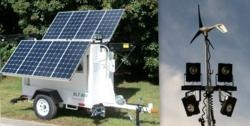Progress Solar Solutions' portable light towers taking off
 You’ve seen them shining bright at night along roadways under construction, at nighttime sporting events, and concerts—portable light towers, and more often than not they’re powered by a noisy, stinky diesel generator. Progress Solar Solutions is changing that.
You’ve seen them shining bright at night along roadways under construction, at nighttime sporting events, and concerts—portable light towers, and more often than not they’re powered by a noisy, stinky diesel generator. Progress Solar Solutions is changing that.
The company, which started about two-and-a-half years ago, offers quiet, solar-powered portable light towers and is introducing solar/wind hybrid models of the popular tools. And while these towers have wings covered with solar panels, they’re not taking off, the North Carolina-based business is.
“We opened a second production facility in October and have a third opening up in January,” said Dan Robertson, a partner in the company.
In the past year and a half, all the major heavy equipment rental companies in the U.S., like Sunbelt Rentals, Hertz and Caterpillar, have started offering Progress Solar’s light towers as rental options. They’re also being used by the Pentagon and each branch of the military, according to Robertson.
“They’ve proven themselves to outperform for light and durability in every one of those applications,” he said.
The systems were designed to meet military needs, according to Robertson.
“We designed them so there would be plenty of redundancy,” he said. “Each solar array is paired with a large bank of batteries, the appropriate controllers and two flood lights. The wind also feeds the battery banks.”
The system can also be charged via an AC cord when needed. Such charges could occur when the unit’s been in storage for a period of time or when there’s been an extended period without sun or wind.
The units, which use high-power, highly-efficient LED lights and battery backup, sell at a significant premium to diesel based light towers, according to Robertson.
“But the operating costs are essentially nothing,” he said. “So right now a diesel light tower generator may cost $24,000 or more a year to operate.”
Between fuel costs, maintenance and operating costs, the cost of one of the solar and/or wind light towers is significantly less over time. They can even be timed to turn on and off automatically.
“It pays for itself in a year to a year and a half for most customers—without incentives,” Robertson said.
But they qualify for the 30 percent tax incentive for solar and a first year depreciation incentive.
Light-tower renters are able to rent the systems for more as well, often twice as much, Robertson said. But again, users don’t have to pay the $500 to $800 a month in fuel costs for the systems, so between the additional rental costs and the need for less fuel the renter still ends up reducing their operating costs for renting such a system.



